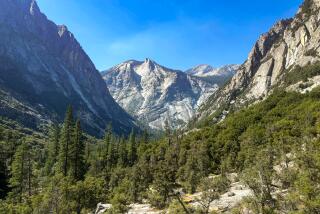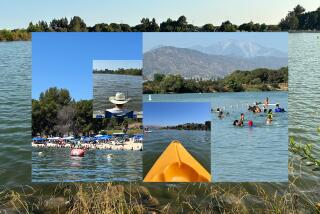Discovery of National Wilderness Playgrounds : FORESTS:
- Share via
Almost by chance last summer, I stumbled on a vast and almost empty mountainscape in central Idaho called the Sawtooth National Recreation Area. A curious name, I thought, and I was almost as intrigued by it as by the scenic beauty around me.
The “Sawtooth” part I understood. In front of my eyes rose a long ridge of high, jagged peaks looking like the teeth of a saw. What puzzled me was the designation “national recreation area.” What did it mean? The best answer I could come up with--looking around me--was a wilderness playground.
Actually, I wasn’t too far off the mark. Dotted across the American map is an unusual type of national park and forest land that has been set aside primarily for outdoor recreation. But they really aren’t national parks and they aren’t national forests, although they look like these areas and the same people run them.
“They’re treasure houses of outdoor recreation opportunity, but very few people know about them,” says Elizabeth Estill, director of recreation, cultural resources and wilderness management for the U.S. Forest Service. “They contain spectacular scenery, great camping, abundant wildlife, clear blue water.”
At 756,000 acres, the Sawtooth is just a little larger than the state of Rhode Island. That’s a lot of land to play in. In a two-day visit, I could only swim in a couple of its 400 lakes or explore a few of its hundreds of miles of hiking trails.
A Sawtooth pamphlet lists such other summer recreational activities as lake and stream fishing, horseback riding, camping, mountaineering, motorbiking, birdwatching, canoeing and waterskiing. Winter brings its own diversions.
Currently, there are 34 national recreation areas. Because they are little-known, many of the national recreation areas are underused, say federal officials. However, several of them offer a vacation experience that can rival the country’s often crowded national parks . . . particularly if you intend to camp.
I liked the Sawtooth so much, my wife and I are returning this summer for a week. We plan to stay in a cabin on a working cattle ranch with a great view of the Sawtooth range.
The newest national recreation area, established May 17, is Grand Island National Recreation Area. The 13,000-acre island, located offshore from Munising, Mich., is one of the largest in Lake Michigan. Once it was the home of the Ojibwa Indians, and fur traders established posts in the 1700s. Though still quite primitive, the island is a scuba-diving site for exploration of old shipwrecks.
The recreation areas are administered by one of three federal agencies: the National Park Service, which oversees 18; the U.S. Forest Service, which manages 15 (including Sawtooth and Grand Island), and the Bureau of Land Management, which is responsible only for one--the one-million-acre White Mountains National Recreation Area in Alaska. Panning for gold on Nome Creek attracts many visitors to this remote mountain region.
A recreation area differs from a national park in that its primary focus is on recreation, which may include hunting. National parks such as Yosemite and Yellowstone offer plenty of recreational opportunities, of course, but one of their basic purposes is the preservation of outstanding scenic sites. Hunting generally is prohibited.
At recreation areas administered by the U.S. Forest Service, any logging or other commercial use must not threaten the land’s recreational potential.
The idea to set aside U.S. land as national recreation areas was conceived after World War II, although most of the areas have been established since 1963. The initial criterion set by Congress was that such areas had to be located near large population centers, so they would be accessible.
Today, however, there are exceptions, says Bob Cron of the U.S. Forest Service in Washington, D.C., including Hells Canyon National Recreation Area on the Oregon-Idaho border. Much of Hells Canyon--an 8,000-foot-deep channel cut by the Snake River--is a wilderness intended for use by backpackers and trail riders.
On the other hand, two large recreation areas are in the midst of major urban centers. The 26,000-acre Gateway National Recreation Area stretches along the Atlantic Ocean near and around New York Harbor, offering urban residents in New York and New Jersey access to long, sandy beaches by subway, bus and car.
The Golden Gate National Recreation Area draws more than 20 million visitors annually to beaches along the shoreline of San Francisco and neighboring Marin and San Mateo counties.
One of the earliest national recreation areas was established in 1946 around Washington state’s Coulee Dam--the outgrowth of a congressional idea that these areas would be created around the lakes formed by new dams being constructed after World War II. The Coulee Dam area’s principal feature is the 130-mile-long Franklin D. Roosevelt Lake, with 32 campgrounds and 16 public boat ramps for boating, waterskiing and fishing.
But the early idea of using dam sites ran into a snag, says Duncan Morrow, a spokesman for the National Park Service. The Delaware Water Gap National Recreation area initially was planned to surround a lake to be formed by damming the Delaware River.
Conservationists fought the dam successfully, however, and it never was built. Congress decided to go ahead with the recreation area. It preserves the landscape for 28 miles on both the New Jersey and Pennsylvania sides of the Delaware River, where it flows through a gap in the Appalachian Mountains.
Perhaps because they are not famous parks, many recreation areas have not been developed or maintained for public use as outlined when they were established. A General Accounting Office report last February concluded that lack of sufficient funding had hampered the installation of new campgrounds and other projects at many Forest Service units. Visitor information services and maintenance also have been adversely affected.
Existing campgrounds need rehabilitation and modernization to meet health and safety standards, say Forest Service officials, and new campgrounds are needed to meet an increasing demand. As a result, the Forest Service has launched a publicity campaign to alert the public to the recreation potential of the areas it administers, and maybe to shake more money out of Congress.
Other unusual and inviting national recreation areas administered by the park and forest services include:
--Glen Canyon National Recreation Area, Arizona. Conservationists fought the construction of the Glen Canyon Dam on the Colorado River, because they knew the lake it was to form--186-mile-long Lake Powell--would bury red rock cliffs of spectacular scenic beauty.
That it did, but the lake is in place, and travelers now flock to it for unusual houseboating vacations. Outfitters rent the boats, and you can, after a brief lesson, guide them up any one of countless secluded canyons to fish, swim and waterski.
--Oregon Dunes National Recreation Area, Oregon. Sand dunes reaching 300 feet high stretch for 38 miles along the beautiful Oregon coastline. You can hike along the beach, go surf fishing, join a dune buggy tour or rent an off-road vehicle for a drive on your own. When I stopped at Oregon Dunes a couple of years ago, I joined a group of youngsters and their parents sledding down the steep dunes on large pieces of cardboard supplied by a couple who ripped up a box in the trunk of their car. Campsites are available.
--Mt. Rogers National Recreation Area, Virginia. Virginia’s two highest peaks, Mt. Rogers and Whitetop, stand side-by-side more than a mile high, like two youngsters trying to prove’s who’s tallest. Together, they preside over 154,000 acres of outdoor playground. The Appalachian Trail winds through the area for 60 miles, and another 400 miles of hiking trails climb through forested slopes to the summits. Local outfitters offer trail rides on the 67-mile Virginia Highlands Horse Trail. Camping and trout fishing beside forest streams is popular, and you will find a pool or two for chilly swimming.
--Flaming Gorge National Recreation Area, Utah. The Flaming Gorge Dam across the Green River impounds the 91-mile-long Flaming Gorge Lake. Above the dam, water sports such as waterskiing, power boating, sailing and swimming are the big attractions. Below the dam, rafting through the 1,400-foot-deep Red Canyon of the Green River is a popular family activity.
More to Read
Sign up for The Wild
We’ll help you find the best places to hike, bike and run, as well as the perfect silent spots for meditation and yoga.
You may occasionally receive promotional content from the Los Angeles Times.






